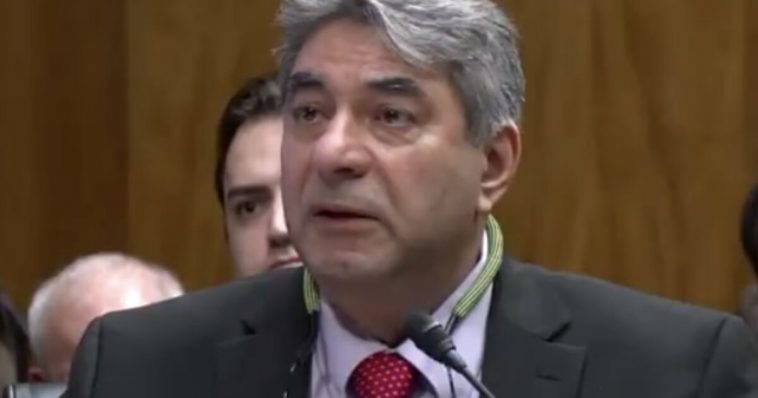From 100PercentFedUp - READ ORIGINAL
Some media, including videos, may only be available to view at the original.
An engineer at Boeing testified before a Senate investigations subcommittee that the company’s 787 Dreamliner aircraft could “fall apart” due to quality issues in the manufacturing process.
“A Senate investigations subcommittee examines the allegations of major safety failures at Boeing in a hearing featuring an engineer from the plane maker who claims that sections of the skin on 787 Dreamliner jets are not properly fastened and could eventually break apart. The whistleblower, Sam Salehpour, sent documents to the Federal Aviation Administration, which is investigating the quality and safety of Boeing’s manufacturing,” the Associated Press wrote.
“They are putting out defective airplanes,” Salephour told the subcommittee.
“Are these planes safe?” Sen. Josh Hawley (R-MO) asked.
WATCH:
Wow. Boeing whistleblower essentially tells @HawleyMO he doesn’t think their planes are safe.
AND he’s been telling Boeing this for years but all they’ve done is sideline him, transfer him, and threaten him. pic.twitter.com/iB7ZVCcgQn
— Abigail Jackson
(@abigailmarone) April 17, 2024
From the Associated Press:
Salehpour was testifying about Boeing’s 787 Dreamliner, hundreds of which are in use by airlines, mostly on international routes. He spoke while another Senate committee held a separate hearing on the safety culture at Boeing.
The dual hearings were a sign of the intense pressure on Boeing since a door-plug panel blew off a 737 Max jetliner during an Alaska Airlines flight in January. The company is under multiple investigations, and the FBI has told passengers from the flight that they might be victims of a crime. Regulators limited Boeing’s rate of aircraft production, and even minor incidents involving its planes attract news coverage.
Salehpour alleged that workers at a Boeing factory used excessive force to jam together sections of fuselage on the Dreamliner. The extra force could compromise the carbon-composite material used for the plane’s frame, he said.
The engineer said he studied Boeing’s own data and concluded “that the company is taking manufacturing shortcuts on the 787 program that could significantly reduce the airplane’s safety and the life cycle.”
Salehpour said that when he raised concern about the matter, his boss asked whether he was “in or out” – part of the team, or not. “‘Are you going to just shut up?’ … that’s how i interpreted it,” he said.
WATCH:
“I want to make clear that I have raised these issues over 3 years. I was ignored. I was told not to create delays. I was told, frankly, to shut up.”
WATCH: Boeing Whistleblower Sam Salehpour testifies Wednesday in front of Congress. pic.twitter.com/BSnkD6Itfq
— MSNBC (@MSNBC) April 17, 2024
“Sam Salehpour, who is still employed by the company, said he even faced physical threats after raising concerns,” POLITICO noted.
“I was ignored, I was told not to create delays, I was told, frankly, to shut up,” Salehpour said.
BREAKING REPORT:
Whistleblower set to provide BOMBSHELL TESTIMONY to congress on massive dangers in development and grounding of Boeing 787 Dreamliner…
‘The Plane Will Fall Apart at the Joints.’https://t.co/4cPzutz2Px
— Chuck Callesto (@ChuckCallesto) April 17, 2024
POLITICO reports:
Boeing declined to comment on Salehpour’s remarks, but it has repeatedly expressed that its regulatory protocols encourage all employees to speak up when issues arise, saying that “retaliation is strictly prohibited at Boeing.”
Boeing has been under intense scrutiny for its manufacturing practices since a door panel blew off a Boeing 737 MAX airplane over Oregon in January. Salehpour worked on two different planes, the Boeing 787 and 777, but senators called the hearing on company-wide safety culture.
Ed Pierson, a former Boeing engineer who is now executive director of the Foundation for Aviation Safety, also said that records of who installed the door plug, which federal safety investigators have been unable to obtain from Boeing, do in fact exist, and accused Boeing of engaging in a “criminal cover-up.”
Jennifer Homendy, the head of the independent National Transportation Safety Board which is investigating the Alaska Airlines door plug incident, said last month that Boeing refused to provide records about who specifically installed the door panel, and she reiterated last week that she was still waiting. Homendy told lawmakers last month that Boeing CEO David Calhoun told her that the company “has no records of the work being performed.”
But Pierson said an internal whistleblower provided those documents to him and he had in turn given them to the FBI.
Watch the testimony below:


